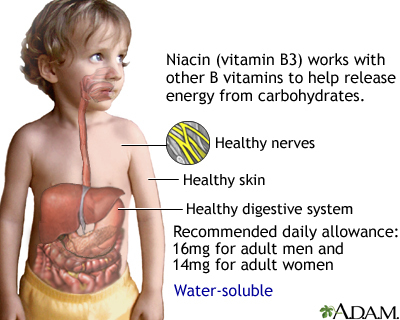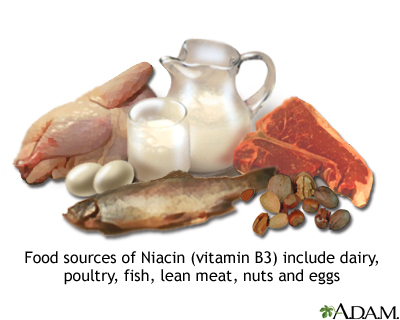Niacin
Definition
Niacin is a type of B vitamin. It is a water-soluble vitamin. It is not stored in the body. Water-soluble vitamins dissolve in water. Leftover amounts of the vitamin leave the body through the urine. The body keeps a small reserve of these vitamins, but they have to be taken on a regular basis to maintain the reserve.
Alternative Names
Nicotinic acid; Vitamin B3
Function
Niacin helps the digestive system, skin, and nerves to function. It is also important for changing food to energy.
Food Sources
Niacin (also known as vitamin B3) is found in:
- Milk
- Eggs
- Enriched breads and cereals
- Rice
- Fish
- Lean meats
- Legumes
- Peanuts
- Poultry
NIACIN AND HEART DISEASE
For many years, doses of 1 to 3 grams of nicotinic acid (another name for niacin) per day have been used as a treatment for high blood cholesterol.
Niacin can help in increasing the level of good cholesterol (HDL cholesterol) in the blood. It can also bring down the amount of unhealthy fat in the blood. Always talk to your health care provider before starting any supplements.
Side Effects
DEFICIENCY:
A deficiency of niacin causes pellagra. The symptoms include:
- Digestive problems
- Inflamed skin
- Poor mental function
HIGH INTAKE:
Too much niacin can cause:
- Increased blood sugar (glucose) level
- Liver damage
- Peptic ulcers
- Skin rashes
When given as a treatment for people with high cholesterol, niacin supplements can cause “flushing.” It is a feeling of warmth, redness, itching or tingling of the face, neck, arms or upper chest.
To prevent flushing, do not drink hot beverages or alcohol with niacin.
New forms of niacin supplements have less side effects. Supplements in the form of nicotinamide or niacinamide do not appear to cause side effects.
Recommendations
REFERENCE INTAKES
Recommendations for niacin and other nutrients are provided in the Dietary Reference Intakes (DRIs), which are developed by the Food and Nutrition Board at the National Academies of Sciences, Engineering, and Medicine. DRI is the term for a set of reference values that are used to plan and assess the nutrient intakes of healthy people. These values, which vary by age and sex, include:
- Recommended Dietary Allowance (RDA): average daily level of intake that is enough to meet the nutrient requirements of nearly all (97% to 98%) healthy people.
- Adequate Intake (AI): when there is not enough evidence to develop an RDA, the AI is set at a level that is thought to ensure enough nutrition.
Dietary Reference Intakes for niacin:
Infants (AI)
- 0 to 6 months: 2 milligrams per day (mg/day)
- 7 to 12 months: 4 mg/day
Children (RDA)
- 1 to 3 years: 6 mg/day
- 4 to 8 years: 8 mg/day
- 9 to 13 years: 12 mg/day
Adolescents and Adults (RDA)
- Males age 14 and older: 16 mg/day
- Females age 14 and older: 14 mg/day, 18 mg/day during pregnancy, 17 mg/day during lactation
Specific recommendations depend on age, sex, and other factors (such as pregnancy). Women who are pregnant or breastfeeding need higher amounts. Ask your provider which amount is best for you.
The best way to get the daily requirement of essential vitamins is to eat a balanced diet that contains a variety of foods.
Gallery



References
Markell M, Siddiqi HA. Vitamins and trace elements. In: McPherson RA, Pincus MR, eds. Henry's Clinical Diagnosis and Management by Laboratory Methods. 24th ed. Philadelphia, PA: Elsevier; 2022:chap 27.
Mason JB, Booth SL. Vitamins, trace minerals, and other micronutrients. In: Goldman L, Schafer AI, eds. Goldman-Cecil Medicine. 26th ed. Philadelphia, PA: Elsevier; 2020:chap 205.